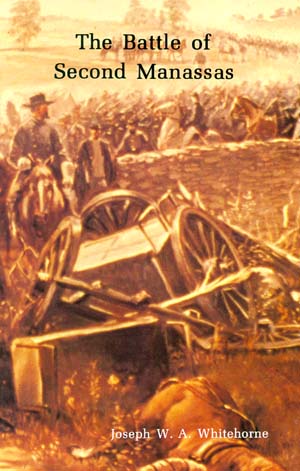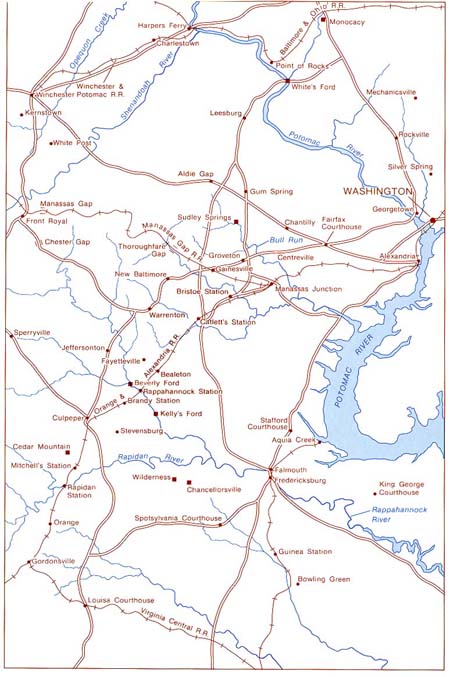


Unless otherwise credited the photos [NOTE: PHOTOGRAPHS NOT INCLUDED IN INTERNET EDITION] used herein are derived from: James Longstreet, From Manassas to Appomattox: Memoirs of the Civil War in America, Philadelphia: Lippincott Co., 1896; Battles and Leaders of the Civil War, New York: The Century Co., 1887; Lee Takes Command: From Seven Days to Second Bull Run, Alexandria, Va.: Time-Life Books, 1984: from photos on file at the National Archives and Records Administration, Washington, D.C.; and from the Library of Congress. Maps are by John R. Treiber. The cover art for this brochure appears in Battles and Leaders, Vol. II. It is from an engraving in black and white, for which a color version has been contributed by the Manassas National Battlefield Park.
The quotations in this booklet are derived from the following sources: Hunter McGuire's Stonewall Jackson; Abram Smith's History of the Seventy-Sixth Regiment; Philip Cheek and Mair Pointon's History of the Sauk County Riflemen; Rufus Dawes' Service with the Sixth Wisconsin; William Chapman's "Dixie Battery at 2d Manassas"; Daniel Leasure's "Observations in the Pope Campaign in Virginia"; Col. David Strother's "Personal Recollections of the War"; Edward McCrady's "Gregg's Brigade in the 2d Manassas"; Oliver Bosbyshell's The Forty-Eighth Regiment in the War; J. G. Beatty's "Second Bull Run"; Marsena Patrick's Journal; William McClendon's Recollections of War Time; Henry Blake's Three Years in the Army of the Potomac; Martin Haynes' History of the Second New Hampshire Regiment; William Jones' Diary; George Lewis' History of Battery E, 1st Rhode Island Artillery; Joseph Polley's Hood's Texas Brigade; Alexander Hunter's Blue and Gray; Philip Faulk's "A Fighting Regiment . . ."; T. E. Shoemaker's Elmira Weekly Journal; Charles Walcott's History of the Twenty-First Massachusetts Regiment; and The Official Record of the War of the Rebellion.
For sale by the Superintendent of Documents, U.S. Government Printing Office, Washington, D.C. 20402
We study our military past not only to draw inspiration from the exploits
of those American soldiers and their commanders who went before us, but
also to sharpen our knowledge and understanding of the art of war, thereby
equipping us for the military challenges of the future. It is our belief
that the careful study of battlefields such as Second Manassas allows today's
military students to understand better the complexities and inevitable
pressures of warfare. It can also provide them the chance to reflect on
and assess military operations, an opportunity rarely attainable in the
daily execution of their craft. This is the third in a series of booklets
on American battlefields intended to help soldiers use the past to enhance
their understanding of the Amy's future.
| Washington, D.C.
1 September 1989 |
MICHAEL D. KRAUSE
Colonel, USA Acting Chief of Military History |
The contest around Groveton, Virginia, on 29 and 30 August 1862 was characterized by complex maneuvers and fighting over the same areas at several different times. New units were funneled into the battle throughout its course, while others were rushed from one point to another as the action shifted. As a result, it is not possible to cover the ground chronologically, to follow the sequence of events in an orderly manner. This lack of order is a reflection of the high level of confusion experienced at the time. At its simplest, after an engagement the previous night, the first full day of the battle may be said to have consisted of three fierce Federal attacks conducted piecemeal against the positions of Jackson's corps, then a meeting engagement between the divisions of Hood and Hatch in the evening. The second day was a quiet morning followed by a fierce Federal attack in the afternoon, succeeded by an overwhelming Confederate counterattack that soundly defeated Maj. Gen. John Pope's army.
The tour will go to twelve locations important to aspects of the battle. Although it is not possible to arrange in sequence the events because of terrain in relation to the original episodes, the stops have been selected to help the visitor see the battle developing. The courage of the men on both sides was exemplary, but technology has overtaken the tactics they used. Nevertheless, the lessons in leadership, command, the use of intelligence, and the performance of men under stress shown by this battle have a lasting value.
The following "Overview" should be read before taking the tour. Stops
are keyed to the action described in the Overview. Numbered stops are those
made by car. "CR" indicates County Road; "SR" indicates State Road. Stops
with numbers and letters are optional additions to the motor phase of the
tour. In the Overview names of Confederate personnel and units appear in
italic type, Union personnel and units in regular type. [NOTE: IN THE
INTERNET EDITION, PAGE NUMBERS HAVE BEEN OMITTED AND DRIVING INSTRUCTIONS
ARE RENDERED IN BOLD-FACED TYPE; BIOGRAPHICAL DETAILS ON KEY PERSONALITIES
ORIGINALLY CONTAINED AS CAPTIONS FOR PHOTOGRAPHS ARE NOW CONTAINED IN A
SEPARATE DOCUMENT]
| Washington, D.C.
1 September 1989 |
JOSEPH W. A. WHITEHORNE
Lieutenant Colonel, Retired United States Army |
|
Page
|
|
| Foreword |
iii
|
| Introduction |
iv
|
| Overview of the Battle |
1
|
| Suggested Readings |
18
|
| Chronology |
19
|
| Order of Battle |
21
|
| Self-Guided Tour |
28
|
| Stop 1-Pageland Lane |
28
|
| Stop 2-Brawner's Farm |
30
|
| Stop 3-Battery Heights |
33
|
| Stop 4-Confederate Cemetery |
37
|
| Stop 5-Railroad Parking Lot |
41
|
| Stop 6-Sudley Church |
50
|
| Stop 7-Picnic Area |
52
|
| Stop 8-Stone House |
53
|
| Stop 9A-New York Avenue |
55
|
| Stop 9B-New York Avenue |
57
|
| Stop 10-Chinn's Ridge |
58
|
| Stop 11-Henry Hill |
62
|
| Stop 12-Stone Bridge |
67
|
| Acknowledgments | Inside Back Cover |
| [PERSONALITIES] |
[N/A]
|